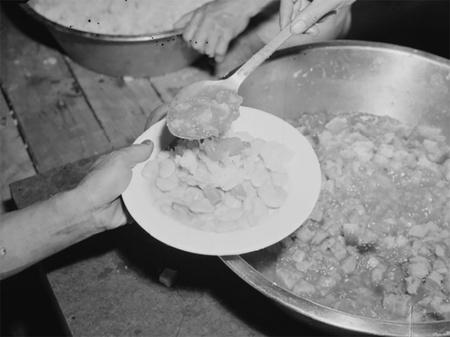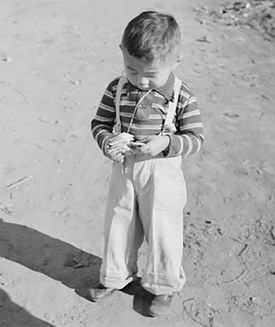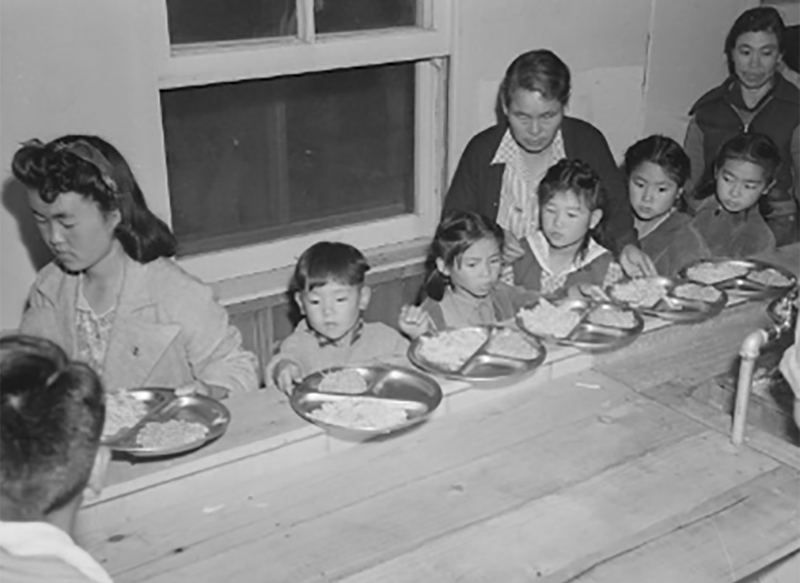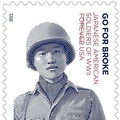World War II shaped the culinary experiences of Japanese Americans in incarceration camps.
The incarceration of 120,000 Japanese Americans during World War II left its mark on the lives of those imprisoned in many ways, including the inability to escape the abnormally large number of hot dogs served at the camps. In 1943, a farewell party for a group of Japanese Americans leaving the Rohwer prison camp in Arkansas included baked weenies. A Fourth of July celebration at the Manzanar camp in California featured all-American foods in celebration of the nation’s founding, but one incarceree proclaimed, “By next week we doubt whether there will be an able-bodied man left in Manzanar who can look a hot dog in the eye without flinching.” Some of the Nisei (or second-generation Japanese Americans) were familiar with hot dogs as an Americanized food, while the cylindrical meat perplexed the older members of the community.
Hot dogs and Hormel’s versatile canned pork product, SPAM, became staples of the Japanese American incarceration experience as cheap sources of protein. Recipes for weenie royale (a casserole of chopped onions, soy sauce, eggs, rice, and of course, weenies) and SPAM sushi are testaments to how meals served in the camps inspired new dishes out of necessity. But creative uses of processed meat only tell part of the story of how food was as central to the wartime experience of Japanese Americans as it was to the rest of the nation.
The Japanese American prison camps were subject to rationing and restrictions during the war, like every household in the United States. After President Franklin D. Roosevelt placed US Army Lt. Gen. John L. DeWitt in charge of establishing military zones along the West Coast and “evacuating” (or removing) those whom he felt were security risks, the task of organizing the logistics of removal and detention in temporary “assembly centers” (or detention centers) fell to the Army. The US Quartermaster Corps established the policies for feeding Japanese Americans and aimed “to provide the evacuees with good substantial food of a quality and quantity available to the general public” in the mess halls.
Japanese Americans were “allotted sugar, coffee, and ration points for processed foods and meats in accordance with the regulations governing all civilian institutions.” Food costs were restricted to $.45 per day per person (or $7.37 today), and the War Relocation Authority (the civilian agency charged with overseeing the day-to-day operations of incarceration) expected incarcerees to be “self-supporting” by supplementing rations with food they produced. This included large scale farming projects (in addition to tending to smaller plots of land for more specialized crops) and raising swine and cattle for meat and dairy products.
In the detention centers and the camps, administrators attempted to offer variety at meal times. A sample menu for the month of June in 1942 shows precisely what Japanese Americans ate at the Santa Anita detention center in southern California. Breakfast was a mix of stewed prunes, figs or apricots, oranges, one half of a grapefruit, corn mush or oatmeal, eggs or pork sausage, and milk for children and coffee for adults. For lunch, Japanese Americans who worked in the mess halls served up salads, sliced bologna, beef or veal stews, potatoes, and fruit or Jell-O for dessert. Cooks kept busy by thinking of creative ways to incorporate the bits and pieces of beef allotted to Japanese Americans, including three different kinds of meatballs and meat loaves. Fish, pork, and stews accompanied by boiled vegetables (which were often brown and wilted by the time they arrived at the kitchen) were frequently rotated for dinner, while treats like rice pudding and ice cream were often saved for special occasions. And, of course, those frankfurter weenies made their appearances at lunch and dinner.

Laurel Fujii, a Yonsei (or great-grandchild of Japanese immigrants to the United States), interviewed her great-aunt Eiko Matsuoka on her memories of the food served at the camps. Matsuoka, who was 15 years old when she was detained, along with her family at the Amache prison camp in Colorado, recalled that the Issei (first-generation Japanese immigrants) and Nisei cooks often did not know what to do with some of the new foods they encountered. Bowls of “white stuff that looked like Crisco” confused Matsuoka, who had no idea what to do with it until kitchen workers added yellow food dye to resemble butter. Beef tongue also presented a challenge to the chefs. “You have to simmer or boil it, and you take off the outer skin with the little taste buds,” Matsuoka explained. “The cooks didn’t do that. They cooked the whole tongue and sliced it, so there was all this skin on the tongue that we ate.”

Though Japanese Americans did not always have control over what they ate and how it was served in the mess halls, there were opportunities to purchase additional items from the camp canteens. Incarcerees could earn money by working a variety of jobs from “skilled” (doctors, nurses, newspaper editors, teachers, etc.) to “unskilled” (infrastructure, mess hall duties, including waitressing and washing dishes, and cleaning) labor which paid from 12 to 19 dollars per month. The administration provided basic necessities, but supplementary materials were left to Japanese Americans to purchase. A typical canteen was stocked with cookies (banana flips were popular), crackers, candy, apples, a variety of juices, and peanuts—all available for purchase at five to 10 cents per item.
Sometimes the starchy meals served in the mess halls and sugary sundries for sale in the canteens presented health challenges for Japanese Americans with special dietary needs. Akiyo Deloyd remembered that the food at the Santa Anita Assembly Center—macaroni, potatoes, and bread—exacerbated her mother’s diabetes. Accustomed to eating a diet of mainly soy and fresh vegetables, Deloyd and her mother were unfamiliar with the carbohydrates they encountered. Her mother died while imprisoned in the Poston camp in Arizona, and Deloyd credited her physical struggles to the poor diet and stress she experienced.
Despite the culinary reality in the camps, rumors spread among Americans that the incarcerees were receiving extra portions of products that were rationed. Sugar—a necessity in producing industrial alcohol for rubber and other war materiel—was in short supply, and because Japanese Americans dined on desserts like puddings and ice cream, Americans conjectured that the imprisoned were receiving special privileges. Congress contributed to these qualms by suggesting that the WRA was “coddling” Japanese Americans.
In response, Eleanor Roosevelt visited the Gila River camp in Arizona in 1943 and reported that Japanese Americans were subject to rationing just like other Americans. “When I read the accusations against the Authority for acquiring quantities of canned goods…I realized there was a lack of understanding of one basic fact, namely, that government authorities such as this have to live up to the law, and if it is the law of the land that we are rationed, we are rationed everywhere…even the War Relocation Authority cannot buy more than is allowed for the number of people they have to feed,” she explained.
The last of the camps closed in 1946, and President Harry Truman dissolved the WRA later that year, but many like Eiko Mitsuako carried their memories of the food they ate there with them. Not all experiences in the camps were characterized by feelings of loss; some traditions continued despite the challenges. Japanese Americans were able to celebrate the traditional mochitsuki in late December of 1942 in Manzanar, turning “steamed rice into delicious white rice cakes.” The Manzanar Free Press reported that “all able-bodied persons in their respective blocks [or group of barracks]” lent a hand in the “war-time version” of the tradition. Japanese Americans experienced wartime changes in the food they ate and the traditions they struggled to keep alive when faced with limits on their freedom.
*This article was originally published on the website of the National WWII Museum at New Orleans on July 7, 2021.
© 2021 Stephanie Hinnershitz




